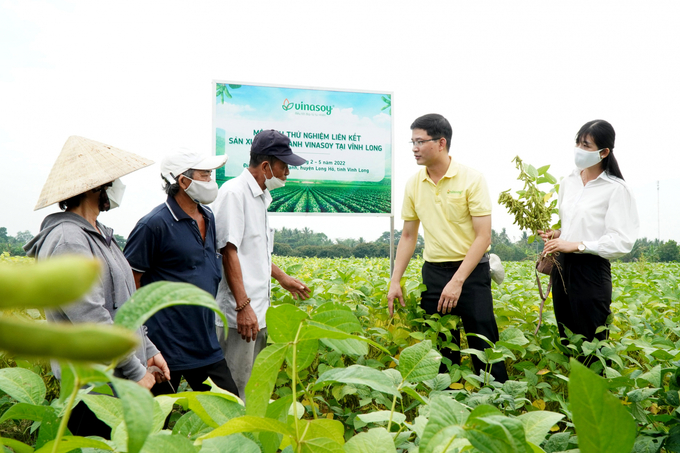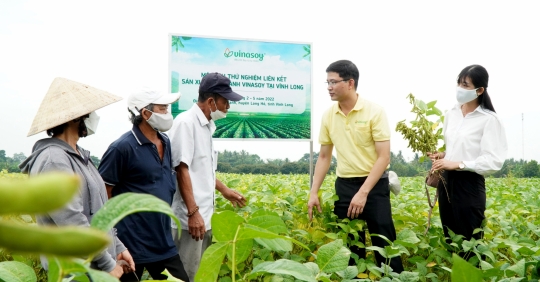To mark the milestone of 25 years of journey, Vietnam Soy Milk Company (Vinasoy) has announced a new vision and mission. Ngo Van Tu, CEO of Vinasoy, shared that Vinasoy’s new vision is “to continuously create a world-class phytonutrient ecosystem by 2030” and mission is to “pioneer in the development of nutritional solutions” encompassing bringing healthy living into every home bring, proud symbol of Vietnamese plant nutrition experts turning to the world”.

Vinasoy works with farmers to build acreage for soybeans. Photo: thanh son.
Vietnamese traditional soybean paste
According to Mr. Ngo Van Tu, Vinasoy has established Vinasoy Soybean Application Research Center (VSAC) since 2013 to contribute to the realization of plant nutrition ecosystem. VSAC is not only the first soybean research center in Vietnam, but also the largest soybean research center in Asia-Pacific. The center brings together good experts and enthusiastic scientists at home and abroad to research and develop genes, select, manufacture and restore traditional Vietnamese soybean varieties, thus forming high-energy soybean varieties that offer higher yield and easier cultivation.
After many years of diligent collecting and researching, VSAC owns 1,533 valuable soybean genetic resources until now. With this genetic resource and the application of molecular genetic technology, Vinasoy has successfully developed two new soybean varieties, VINASOY 01-CT and VINASOY 02-NS, both varieties have been awarded a protection certificate by the Ministry of Agriculture and Rural Development Seed Households. In particular, the VINASOY 02-NS soybean variety has been approved for mass production by the Ministry of Agriculture and Rural Development in the Central Region, Central Highlands, Red River Delta and Mekong Delta thanks to its wide range of adaptability with high yields ranging from 2.5 to 5 years 3.5 tons/ha.
Over the years Vinasoy has worked with farmers in many locations to produce the experimental soybean varieties VINASOY 02-NS and all have shown positive results. Mr. Pham Van Duan, a farmer in Hamlet 14, Dak D’rong Township, Cu Jut County, Dak Nong Province, said: In the past, his family grew old soybean varieties that yielded only 2 tons/ha.
Since he teamed up with Vinasoy to grow VINASOY 02-NS, his family’s soybean yield has reached over 3 tons/ha, the recent harvest has reached 3.4 tons/ha. The higher yield was excellent, and Vinasoy bought them back at a price of about 5,000 VND/kg above the market, so the profit after cost was about 50 million VND/ha/crop, much higher than the same variety .old soybeans.

Soybean variety VINASOY 02-NS. Photo: thanh son.
In Mekong Delta, Vinasoy has planted VINASOY 02-NS soybean variety on rice soil in Cao Lanh (Dong Thap) and Long Ho (Vinh Long) districts as of 2020. The results show that this soy variety grows very well on the test plots.
In the 2022 spring-summer harvest, Vinasoy continues to carry out a trial model of cooperation with farmers on a larger scale, including 10 hectares in Tan Thoi Hamlet, Tan Hanh Township, Long Ho District (Vinh Long) and 5 hectares in Phu Town location , Thanh Tri District (Soc Trang). All models bring farmers high profitability.
Especially by working with farmers, Viansoy always creates credibility by providing good seeds, guiding farming techniques and buying standard products at higher prices than the market. Therefore, many farmers in the central highlands, in the Mekong Delta … are closely linked to the company through many soybean crops.
Based on the success of the pilot models, in the coming period, Vinasoy will work and collaborate with farmers to develop large-scale soybean material areas in the Mekong Delta (potentially over 5,000 ha), Central Highlands (over 5,000 ha), the Central (500 -600 ha) and the Red River Delta (over 1,000 ha).
The development of the same raw materials, soybeans, will be an opportunity for communities to change the structure of crops, flexible seasons; increase income for farmers; At the same time, it will be a condition to contribute to soil improvement and the development of ecological and sustainable agriculture because soybean is a crop with excellent soil improvement function.
VINASOY 02-NS soybean variety has many advantages such as high yield, good tolerance, concentrated ripening time, so it can be mechanized in the harvesting stage to reduce production costs. Vinasoy has perfected the cultivation process, applied mechanization and worked with farmers to develop resource areas. This is a good opportunity for soybeans in our country to grow back from about 200,000 ha in 2010 to less than 40,000 ha in 2022 after a long period of sharp acreage declines.
(Mr. Nguyen Nhu Cuong, Director of Crop Production Department)
Building a plant nutrition ecosystem
Phytonutrients are emerging as a global food consumption trend. Mr. Ngo Van Tu said that the potential market for phytonutrients is huge both in the world and in Vietnam. A report by Data Bridge Market Research shows that the global phytonutrient market will grow at 7.4% per year through 2029. In Vietnam, according to a survey by Rakuten Insight, 86% of consumers have chosen phytonutrient solutions.

Vinasoy soy milk is present in many foreign markets. Photo: thanh son.
Meanwhile, the Vietnamese diet lacks the balance between animals and plants. According to Assoc. Prof. Dr.Truong Tuyet Mai, deputy director of the Institute of Nutrition (Ministry of Health), the amount of animal protein in the Vietnamese’s meals has increased rapidly over the past 10 years. Currently, the average meat consumption is 153-154 grams/person/day.
That’s a very large number, because according to the recommendation of the International Association for Cancer Prevention, each person should only consume an average of about 90 grams of animal protein per day. Despite using too much animal protein, the amount of vegetables and fruits that the Vietnamese consume is just over 300g/day, falling short of the 400g/day recommended by the World Health Organization.
Therefore, in the Vietnamese diet, it is necessary to improve the sources of phytonutrients such as vegetables, beans, nuts, etc., in order to make the meal healthy, balanced and complete, thereby providing the body with all the nutrients it needs. Improving plant nutrition also helps protect the environment by reducing greenhouse gas emissions…
Prof. Dr. Le Thi Hop, former director of the Institute of Nutrition, said both animal protein and plant protein are important for the body’s development and provide people with energy. Each type has advantages and disadvantages. Plant proteins have advantages over animal proteins, such as B. that they are cheaper, easier to digest and have many very good health effects. Thanks to the advantages of low cost and local availability, plant-based protein, particularly soy milk, has made a major contribution to improving child malnutrition in rural Vietnam in recent years.

A soybean testing station in the central highlands was built by Vinasoy. Photo: thanh son.
Given the importance of phytonutrients as well as the great market potential, Vinasoy has seized the opportunity to expand the ecosystem of plant products with a strategy of focusing on the plant products axis Development of essential nutritional products from soybeans; Development of dairy products from plants such as drinking yoghurt, nut milk; develop healthy plant-based meat products, conserve natural resources and protect the environment.
At the same time, Vinasoy will research and provide the most innovative seeds, techniques and sciences based on core competencies; Brings Vietnamese phytonutrient products to the world and engages in many domestic and international commercial business activities. Introducing a new vision along with an ecosystem of phytonutrient products shows that Vinasoy anticipates the opportunities and development potential of the market in Vietnam and around the world.
With a production capacity of all 3 factories in Quang Ngai, Bac Ninh and Binh Duong of 390 million liters/year, Vinasoy leads the Vietnamese soymilk in cardboard box market with 90% market share and ranks among the top 5 largest soymilk companies in the world for 4 consecutive years Years from 2018 to 2021 (according to Global Data). Currently, Vinasoy is present in important markets such as USA, Korea, Japan, China, Myanmar… Therefore, Vinasoy has full potential and a ready basis for growth in the nutritional market.

